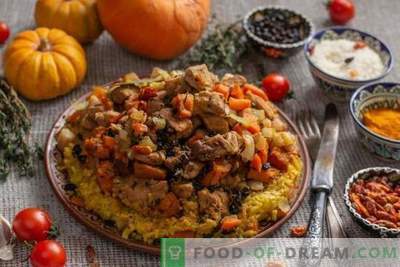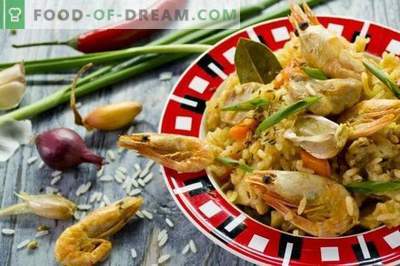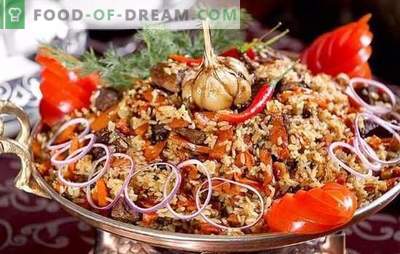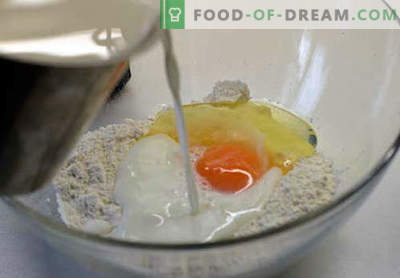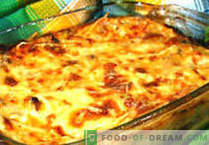
Speaking of the pilaf, one must pay tribute not only to the geography of its distribution, but also to recall the history going back thousands of years.
The etymology of the very name of the dish, consisting of the abbreviations of all the main ingredients, looks like a hint from the ancient healer Avicenna to the descendants of the human race.
Pilau with chickpeas - general principles of preparation.
In vain the ancient physician was worried about the neglect of pilaf. The recipe of pilaf reached us in its original form. It has become an integral part of the festive and everyday menu of most of the inhabitants of the planet. Cooking pilaf has as many variations as housewives cook it.
By the way, according to the Asian tradition, only man should cook pilaf with chickpea for big holidays.
Pilaf, in fact - stewed cereal part, combined in the same recipe with meat and vegetables, also stewed in a cauldron. And not only with meat, but also seafood. Or just a vegetarian dish, without meat and fish.
Pilau ingredients are sometimes cooked separately, serving them also separately, on a platter, or on a flat cake.
It is said that if pilaf is not cooked in a cauldron, then among the peoples of Asia this is considered to be absolute ignorance and unprofessionalism. Similarly, one cannot eat pilaf with a spoon or fork in order not to show oneself as a person who is completely deprived of normal education and knowledge of the rules of etiquette. There, pilaf is eaten only by hand. In extreme cases, you can use the cake, rolled into a cone, and eat it with pilaf.
Severe Asian customs. But pilaf with chickpeas is no less tasty dish, even if you cook it in a roaster. The main thing is that the dishes in which pilaf is prepared should be thick-walled and, while heating, keep the temperature for a long time.
Traditionally, rice is considered the main part of pilau, although Indians and many Asian peoples, who are also credited with authorship of pilaf, very often use a combination of several cereals and legumes in their dishes. The famous Ferghana and Tashkent plov is no exception. Nute, like rice, is one of the most ancient cultures. In the European part of the mainland, this species is not widely spread, but if we take into account its valuable nutritional properties, then buying mutton peas is not a problem.
Pilaf differs from ordinary porridges in friability, despite the quenching of cereals. So you need to pay attention to the preparation of the cereal part.
Chickpeas from the legume family. Rice - cereal. The difference in heat treatment is obvious. If you cook pilaf with chickpeas, without rice, then there will be no problems. The combination of rice and chickpea in one dish requires a certain sequence in technology.
Nuth choose light. Before cooking pilaf with chickpeas, it must be soaked in water for at least twelve hours. Water taken in the ratio of 1/4 (1 part peas, 4 parts water). Dishes with soaked chickpeas are best kept in the refrigerator. You can simply change the water often, but then you will not be able to use a very useful infusion for cosmetic purposes. Water, in which chickpered insisted, has a strong lifting effect. Peas fall into the cauldron much earlier than rice. Cooking time of chickpea in the pilaf - 60-90 minutes.
Rice for pilaf with chickpeas, you need to choose the one that is larger, hard varieties, with the lowest content of starch. It is washed until the water in which the rice is located is completely transparent. Then it should be slightly dried. Turbid water indicates starch content to be removed. Cooking rice in the pilaf is 30-40 minutes on low heat.
Meat for cooking pilaf, you can choose any, despite the fact that the traditional pilaf cooked with lamb. Depending on the type of meat varies cooking time. Bookmark products in such a way that the time of their full readiness eventually coincided.
Fish and seafood are prepared much faster than chickpeas, rice and any other cereals. Therefore, for the preparation of pilaf with chickpeas in the Mediterranean or Malaysian style, the cereal part is pre-soaked and boiled. Then the cereals are added to the ready-made fish component. At least two types of fat are used to make pilaf: vegetable and animal.
Recipe 1. Pilaf with chickpeas without meat
Composition:
• Chickpea (soaked in water) 1 cup
• White cabbage, shredded 300 g
• Mushrooms (any suitable) 1.0 kg
• Onion 0.5 kg
• Figure 0.250 kg
• Carrots 0.5 kg
• Cream (not less than 20%) 300 ml
• Garlic 1 big head
• Ghee 100 g
• Black pepper
• Dill
• Celery stalks
• Turmeric
• Lemon 1 pc.
• Oil, vegetable 50 ml
• Salt, if needed.
Cooking:
The chickpeas for this pilaf must be cooked until half-ready, so as not to overdo the remaining ingredients. And start with carrots. It should not be grated, and cut into straw, as long as possible and thinner. In a cauldron to heat the vegetable oil. After the oil warms up, put a very slow fire, so that the ingredients languish in the cauldron, and not burn. If 50 ml is not enough to stew carrots, add more. Bulbs cut in half and also finely chop into half rings. When the oil in the cauldron becomes beautiful and golden, you can throw the bow and simmer it to transparency. At this stage, add the melted butter. It should warm up before plastics cut into the cauldron. They, 3-4 minutes after roasting, pour cream and add spices, salt. Give the cream to boil and immediately pour the chickpeas, and on top of rice. In the middle we place the garlic head peeled from the upper plates. Fans of spiciness can put hot peppers along with garlic, also whole. All ingredients must be covered with liquid, 2 cm above the level of rice. Therefore, add water (boiling water), if the cream is not enough. Next, we check the readiness of rice and chickpea, after which we pour the chopped cabbage with green celery and dill. Cover with a lid so that the cabbage is steamed and “tired”. If all the liquid is not evaporated during the cooking process, the rice and chickpeas will absorb it while the pilaf is infused.
Recipe 2. Pilaf with “Favorite” chickpea
Composition:
• Steamed rice 250 g
• Dried apricots 400 g
• Raisin, dark 400 g
• Prunes without stones 400 g
• Quince 0.5 kg
• Alycha 0.2 kg
• Chick-pea cooked to half-cooked - 300 g
• Honey 150g
• Butter, ghee 100 g
Cooking:
Slices of quince and cherry plum fry in butter, caramelized honey and spread on a plate. In a cauldron - chickpeas, boiled until half ready, and on top - thoroughly washed rice. Fill with water and simmer on low heat. It does not hurt to add a little salt when the peas and grits are almost ready. On top of the layers lay prepared dried fruit and caramelized slices of quince and cherry plum. Add water with 2-3 tablespoons of honey dissolved in it. If there is little acid, you can squeeze the juice of half a lemon. Cover and simmer another five minutes.
Recipe 3. Pillow with chickpea “Summer”
Composition:
• Chickpeas 100 g
• Cherry 300 g
• Melissa, fresh 1 bunch (large)
• Millet 100 g
• Pepper “Gogoshar” 3 pcs.
• Onion 0.5 kg
• Fig 1 glass
• Carrots 0.5 kg
• Celery 2-3 stalks
• Eggplant 2 pcs. (medium)
• Chicken Breast 1.0 kg
• Spices
• Baked butter
• Olive oil
Cooking:
Cooked chickpeas cook until half ready. In the heated fat lower carrots (straws), then onions (half rings). Next send pieces of chicken breast. Cherry (slices), pepper (straw) and eggplants (cubes) alternately fry separately in a frying pan in a small amount of butter. When frying vegetables, lightly sugar them. We lay chickpeas, rice, millet in a cauldron for semi-finished meat, giving each cereal time to boil. Add water to cover the whole mass, and add spices (optional). Check the readiness of cereals and 5 minutes before the end of cooking lay out the eggplants, peppers, tomatoes. Sprinkle celery and melissa on top. Cover with a lid, remove the fire, and give the prepared dish to stand for 15 minutes.
Recipe 4. Pilaf with chickpeas, prunes and duck breast
Composition:
• Breast duck 1.0 kg
• Duck fat
• Vegetable oil
• Prunes 250 g
• Chickpeas 1 glass
• Buckwheat
• Onions 500-600 g
• Orange 1.0 kg.
• Honey
Cooking:
Duck choose musky. Remove the skin from the duck breast. Cut the breast into small pieces. To throw a skin and duck fat in a heated cauldron. Heat the fat. Skimmer remove the residues. Add a little vegetable oil and fry the onion half rings until transparent. Put the duck meat on an onion pillow, pour it with juice of one orange mixed with honey (2-3 tablespoons). After 15 minutes, lay out a layer of prunes, cut into strips. Then we put a layer of chickpea into the cauldron, pour boiling water over it to cover the peas 2-3 cm, add spices. When chickpea is almost ready, lay out the oranges diced, and on them - steamed buckwheat. If necessary, add water and bring the dish to readiness on low heat.
Recipe 5. Pilaf with chickpeas and pork, separate
Composition:
• Pork 1 kg
• Steamed rice 250 g
• Shallot 1 bunch
• Parsley 1 bunch
• Cilantro 1 bundle
• Onions, red 0.5 kg
• Dry red wine 250 ml
• Carrots 400 g
• Chickpea 2 cups
• Eggs 2 pcs.
• Green peas 1 glass
• Cherry 0.5 kg
• Tomato paste 2- 3 sl. Spoons
• Ground cloves
• Coriander seeds (ground)
• Chile 2 pcs.
• Garlic 1 head
Cooking:
This dish is prepared in stages. The order of each stage can be set arbitrarily, only the meat must be cooked before serving. Meat can be poured over the night with wine and spices. Slices of pork, aged in wine for at least 8 hours, lightly squeeze before cooking.
Boil chickpeas to puree. Beat with a blender, add eggs, salt, spices. After beating add green peas, chopped cilantro, softened butter (50 g). Mix the mass thoroughly and form balls from it.
Cherry blanch and remove the peel. Boil the sauce from tomato paste and water, adding coriander, cloves and other spices. Do not forget to sweeten a bit. Bring sauce to a boil, strain and boil the cherry in it. In a sauce with cherry add shallots, cut into strips. Wash rice to clear water and let it stand in cold water for at least two hours. Boil until half ready. Drain and rinse.
In a cauldron fry carrots, red onions lightly protomit. Collect vegetables with a slotted spoon and fry pieces of meat in fat until cooked. Remove the meat and put the rice in the cauldron. Bring it to readiness and shift to the dish. Top with stewed onions and carrots. Put meat on them. In the remaining fat in the cauldron with broth stew chickpea balls. Put them on the edge of the dish, around the rice. Warm cherry tomatoes in a cauldron again. Cherry lay around the meat, on top of the rice. Heated tomato sauce can be poured over the dish or served separately in a saucepan.
Recipe 6. Pilaf with chickpeas classic, in the Fergana style
Of course, only Fergana residents can cook real Fergana plov. But take the risk! By the way, only a man should cook this pilaf ... So housewives especially do not risk their reputation.
Composition:
• Lamb (ribs) 1 kg (pure meat)
• Raisin 100 g
• Rice (dev-zira) 1 kg
• Barberry 100 g
• Onion 350g
• Chickpeas 100 g
• Carrots 1 kg
• Zira
• Hot peppers
• Garlic 3 heads
• Oil 250 - 300 g
• Fat fat
Cooking:
The weight of chickpea is indicated in dry form. In all Uzbek chickpeas chickens - only an extra touch. It does not particularly affect the taste of the dish. It, as usual, is pre-soaked in water. 300 g of vegetable fat - a lot for a person who is not accustomed to Asian cuisine. A fat tail to get probably difficult. And lamb is far from dietary meat, especially considering that pilaf is traditionally chosen not by a young lamb, but by a rather mature lamb that has fat on its ribs. In a word, what to add and what to take away is up to the cook. In the end, this recipe does not pretend to originality, and style is an individual matter.
In the process of making pilaf, the cauldron is covered with a lid only at the very last moment, when rice comes to readiness and residual liquid is absorbed into it. We cut carrots very thinly and beautifully into straws. Appearance dishes - not the last thing. With lamb ribs to separate the fat, clean the meat from the film, to separate from the bones. Heat the oil. It is better to choose a neutral and refined, so that it does not smoke the kitchen of a city apartment. In the oil, throw all the fat trim and fry until crackers. We take them out of the cauldron with a skimmer. Onions can be cut into 4 pieces and throw it into hot fat and let it burn. Do not get carried away: do not burn to coal, but simply overcook very much. Fry the ribs by adding spirits. Then remove them. You can throw chickpeas - it will prepare for a long time, so you need to put it in the cauldron as early as possible. Fry the carrots. She has to release the juice into fat to paint the dish in a golden color. Carrots should be juicy. Before you send meat to the cauldron, you can fry the onion slices in fat, if desired. Meat is cut into pieces of any size and fried. Now fill the meat with water. Use cool boiling water from the kettle. Switch the oven to slow fire. Next, cook in fire mode. Water is better to pour after laying rice, if necessary. The final pilaf should not float in gravy, but should not be dry. At this point, you can put peeled garlic from the outer layers, a couple of bitter peppers, barberries and raisins. Add cumin and salt. At the time of creation zirvaka laid taste palov. When water is absorbed into the rice, it will be difficult to fix the taste. We lay out the washed and soaked in water rice. Zirvak should appear in the cauldron 1 cm above the level of rice. If there is not enough fluid, add some more water. If it turns out that the rice is not ready yet, and the liquid from the surface has disappeared, cover the pilaf with a lid. Rice comes under the influence of temperature. The finished pilaf is covered with a dish into which it must be shifted and the cauldron is turned over so that the bottom layer of the pilaf is on top.
Recipe 7. Pilaf with chickpeas, quinoa, pomegranate and spices
Composition:
• Cumin (seeds)
• Coriander (seeds)
• Olive oil 50 ml
• Onions 1 pc.
• salt
• Garlic 2 cloves
• Quinoa 400 g (finished cereals)
• Green peas (frozen or canned) 200 g
• Boiled chickpeas 400 g
• Pomegranate, medium 1 pc.
• Pepper
For garnish (optional)
• Thick yogurt 1 cup
• 1 small clove of garlic, grated (optional)
Cooking:
If quinoa is hard to find, you can replace it with bulgur. Quinoa cooks fast.
Wet chickpeas, then cook until done. Heat a large heavy frying pan and throw coriander and cumin seeds into it. Stir until they start to smell, and give them their characteristic aroma of spices. Cool and then grind.
Heat the frying pan again, adding half the oil, one grated clove of garlic and salt to the mashed spices. Stir in cumin and coriander seeds, olive oil. Put in a pan with prepared quinoa spices, with green peas, chickpeas and 3 tablespoons of pomegranate seeds. Heat on medium heat for several minutes. Add salt and pepper to taste. Put on a dish, and decorate with the remaining grains of pomegranate.
Stir the second clove of garlic with thick yogurt. Season the pilaf with the sauce.
Recipe 8. Pilaf with chickpeas, in Indian
Composition:
• Milk 1.2 liters
• Water 2 liters
• Rice (basmanti) 400 g
• Carrots 400 g
• Peanuts, fried 150 g
• Chickpea, boiled 1,5 - 2 tbsp. (350-400g)
• Butter ghee (creamy, melted) 120 g
• Onion 250 g
• Cardamom 3 boxes
• Ginger root, fresh 50 g (or to taste)
• Garlic 3 slices
• Chile (powder)
• Mint, fresh
• Cinnamon
• Cilantro 7-8 branches
• Cloves 5-6 pcs.
• Sugar 3 tbsp. spoons
• Lime wedges
• Turmeric
• salt
Cooking:
Cook the chickpeas in advance, boil them. Wash rice thoroughly and soak for half an hour. Mix 1 l of milk and water with salt, cardamom, cloves, cinnamon, boil. Boil rice in water with milk, drain it in a colander. Green cilantro and mint finely chop and mix with boiled rice. Blender to cook pasta from ginger and garlic. Heat the butter in a pan and put ginger-garlic dressing into it, add chili (optional). After 30 seconds, add the finely chopped onion and pass a minute or two, until transparent. Put carrots with prepared peanuts on a large grater and put them in a frying pan and continue to stew until ready. When the carrots are soft, add chickpeas, mix and warm the mixture a little more, then remove the pan from the heat. Prepare a baking dish, brushing it with oil and dragging it with flour or bread crumbs. In it we spread layers of rice and carrots with chickpeas and peanuts, alternately. From above we pour in milk, in which we preliminarily dilute sugar and turmeric. Send the form to the oven for 10 to 15 minutes. After removing the form, give the pilaf to cool slightly in the form, cover with a dish that will serve pilaf, and turn over the form. Lay a slice of lime around the pilaf (you can substitute lemon).
Recipe 9. Pilaf with chickpeas, dessert
Composition:
• Boiled chickpeas 0.5 kg
• Raisin (dark) 0,250 kg
• Rice devizira boiled 0.5 kg
• Table grapes (white variety) 250 g
• Barberry, fresh (or cranberries, lingonberries) 200 g
• Dates (pitted) 100 g
• Orange syrup 400 ml
• Mint, fresh
• Cashews 1 cup
• salt
Cooking:
Barberry can be replaced by any red berry. Berry should be sour, and red color will give the dish brightness and attractiveness.
Boiled chickpeas boil in orange syrup for about five minutes, stirring constantly, add grapes and barberries. Allow to cool. Soak the washed raisins. Remove the stones from the dates and cut them in half, large. We combine boiled rice with dates, raisins and crushed nuts. Combine both masses, laying out on top of rice, chickpeas with berries. Sprinkle with chopped mint. You can serve sweet pilaf cold.
Pilau with chickpeas - tricks and tips
• If you are going to serve pilaf without cutlery, do not forget to put drinking bowls of water and lemon pieces for your hands.
• Chickpea is combined with any vegetables, other legumes, meat, fish. But it must be remembered that chickpeas contain a lot of starch. And starch is carbohydrates. Try to use more vegetables in chickpea dishes.
• If during the chickpea cooking process two or three times to replace water, it will be possible to avoid discomfort in the intestines associated with flatulence.
• Starch comes out of the chickpea during the soaking process. The water in which the peas were located is an excellent cosmetic. She can wash or make ice cubes. The skin will become more elastic, clear of acne.
Without chickpeas, the taste of any pilaf will not deteriorate. But this culture has been used in human nutrition for more than five thousand years due to its valuable biochemical composition. Add chickpeas to your diet and be healthy!





